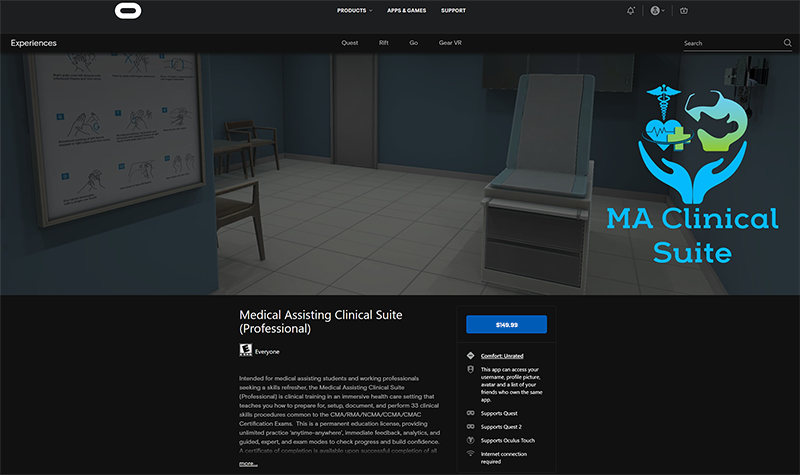A medical assistant may be asked to perform a pediatric assessment as part of a well-child visit to determine growth and developmental patterns, and to assist in identifying congenital problems, abnormalities, and disorders. This skill lab teaches the process of conducting a pediatric assessment, covering how to safely assess the head circumference, weight and length measurements in infants.
This lab is based on the entry-level competencies for which the Commission on Accreditation of Allied Health Education Programs (CAAHEP) and Accrediting Bureau of Health Education Schools (ABHES) test the Medical Assistant.
Learning Sequence Builds Confidence
The learner practices the procedure in the ‘guided mode’ (interaction hints and an expanded checklist guide) as often as they like.
When the learner is confident that they can accurately demonstrate the procedure without error, the learner plays the level in the ‘expert mode’ (no hints or checklist explanations) - which they can repeat as often as they wish.
Finally, when the learner is confident that they have mastered the procedure - they take a one-time ‘exam’ attempt which results in their grade for that procedure.
The Medical Assisting Clinical Suite (Professional) Edition is available for purchase through the Oculus AppLab for $149.99
Features
Guided Mode - ghosted hints show step-by-step positions, learner can 'see through' the patient to verify placement.
Oculus Quest Affordability & Ease of Use - next generation game development processes allow the untethered, mobile VR to present effective visual and interaction fidelity at 1/4 of the cost of desktop VR.
Feedback - Cloud-based enterprise incorporates real-time data acquisition that allows learner to track progress and mastery, and provides detailed insights for debrief with faculty.
Support - Enterprise incorporates Knowledge Base (with tutorial videos & FAQ) - combined with help desk support staff for learners and staff.
Pediatric Assessment Checklist
- Gather supplies: select appropriate growth charts and tape measures.
- Perform handwashing.
- Place disposable paper on the exam table
- Place disposable paper on the scale.
- Introduce yourself to the caregiver. Confirm infants full name and date of birth. Explain the procedures to be performed, allow time for the care-giver to ask questions. Obtain verbal consent to proceed.
- Ask care-giver to remove infant clothing except the diaper.
- Ask the care-giver to position the child for head measurement.
- Place the measuring tape around the infant’s head, encircling the largest diameter. Check that the tape measure is just above the eyebrows and ears.
- Read the measurement to the nearest 0.1 cm and note the reading.
- Reposition the tape and repeat the head measurement.
- Calculate the average of the two measurements and note the calculation.
- Ask the care-giver to remove the infant’s diaper and to place the infant in the middle of the scale.
- Place your hand above the infant for safety. Read the scale when the infant is still. Note the scale reading.
- Ask the care-giver to remove the infant from the scale, put the infant on the exam table and put on the diaper.
- Provide a brief explanation to the care-giver on how to hold the child's head when measuring length.
- Place the measuring mat on the exam table.
- Place the sliding foot piece at the end of the measuring board and check to see that it is sliding freely.
- Ask the care-giver to position the child on the measuring mat, to lay the child down on his/her back with its head against the stationary headboard, and to stand directly behind the child's head.
- Position yourself on the right side of the child so you can hold the foot piece with your right hand
- Position the child's body so that the shoulders, back and buttocks are flat along the center of the mat.
- Place your left hand on the child's knees. Hold the movable foot piece with your right hand and firmly place it against the child's heels. A child's legs and feet can be very strong. You may have to straighten them with your hands.
- When the child's position is correct, read and call out the length measurement to the nearest 1/8". Record the measurement on the data collection sheet under "Recumbent Length".
- Inform the care-giver that the procedure is completed and they can pickup the child from the mat.
- Perform hand hygiene.
- Document the procedure and findings according to agency policy.

